
BUCKEYE RAMBLINGS
The Official Newsletter of the Ohio Lincoln Highway League
Number 59
October, 2009
JUNE ENTHUSIASM IN INDIANA CARRIES THROUGH SUMMER IN OHIO
The good group of Lincoln Highway Association members that attended the annual LHA conference at South Bend in June returned to Ohio with no loss of enthusiasm for promoting and preserving the memory of the nation’s first transcontinental auto route. Several interesting activities were conducted by the two Ohio chapters, and once again the Ohio Lincoln Highway Heritage Corridor witnessed the favorable impact of the annual BuyWay Yard Sale Event. These are encouraging signs in discouraging times, and bode well for future projects.
On an overcast and humid Saturday in July, members and friends of the Mid-Ohio Chapter of the LHA met one mile east of Oceola for one such activity. The goal of this project was to do clean up and perform repairs at an original brick pillar that has survived in this location since 1921. The pillar was built to commemorate the completion of the bricking of this part of the highway, and is the only survivor of what may have been eight pillars in Crawford County west of Bucyrus. Although the present highway is farther away and somewhat lower than the original road, the pillar has stood sentinel for almost eighty years. However, the top bricks of the pillar were in disrepair, and the cement capstone had shifted to a precarious position at the top of the pillar. Weeds had grown up around the pillar to the point where it became nearly invisible from the highway, and debris was strewn about from the felling of that notorious “ratty catalpa” tree. Led by our resident restoration expert Richard Taylor, a group that would eventually number thirteen performed one task or another. Larry Webb came all the way from Van Wert to deliver a new cement capstone, which was carefully placed atop the repaired pillar. Mike Buettner came from Lima with his GPS surveying equipment to finally confirm that the pillar is located within the highway right-of-way. There long has been a concern that the pillar is on the wrong side of the right-of-way line (thus outside the public easement), and it was important to establish once and for all that the pillar is not on private property. This is a most significant matter to consider for all such landmarks if we hope to continue their maintenance.
In August, the BuyWay Yard Sale Event topped all expectations, and continues to experience growth. Jim Cassler reported that there were “wall-to-wall” sales near Robertsville and Minerva. On the other side of the state, Van Wert enjoyed one of their busiest weekends ever, with the BuyWay event taking place at the same time as the Route 127 “World’s Longest Yard Sale.” Mike Hocker estimated about 1000 sales, based on his busy travels during the course of the three-day event. As a result of these successes, the Board of Directors of the Ohio Lincoln Highway Heritage Corridor has voted to schedule future BuyWay yard sales during the same weekend as the Route 127 sale, which traditionally begins on the first Thursday in August. In 2010, those dates would be August 5 through August 7. Special mention should be given to Betty Huber, and to Dick and Gerry Lotze for continuing their yard sale at Robertsville. Although the Lotzes were not home, Betty ran the sale and allowed the Eastern Ohio Chapter to have an information and Trading Post booth at their place.
In September, the two Ohio chapters met at Das Dutch Kitchen near Dalton for their annual joint meeting. Jim Cassler reported that 33 people were in attendance, with nearly equal representation from both chapters. News was presented regarding the construction of a Lincoln Highway park in Wooster, Mike Hocker gave his final review about the BuyWay event, and Ed Cannane gave a “very informative, well-researched and well-presented” program on the history of U.S. Route 30. Mike Sigg, Wooster City Manager, shared that their interpretive park was being planned on the grounds of a new library. The park will have a Lincoln Highway theme, and will include concrete posts, brick pillars, artistic cut-outs of antique cars, and interpretive tablets. The project is scheduled for completion by July 2010.
TWO AMERICAN CLASSICS: ROOT BEER AND THE LINCOLN HIGHWAY
A recent issue of Lincoln Highway Journal, a publication of the Lincoln Highway Heritage Corridor in Pennsylvania, included a fascinating story about root beer entitled "An American Classic: Root Beer." The article gave a brief history of root beer and several root beer brands. With their permission, I have borrowed some excerpts from that article, specifically focusing on two brands—A&W and Stewart's—that have special significance in Ohio because of their place on the Lincoln Highway:
According to the Journal, the 'roots' of root beer can be traced back to the late nineteenth century. The beverage was born at a time when druggists and pharmacists were creating elixirs and tonics to serve as 'miracle drugs.' Root beer was crafted from a variety of herbs, barks and berries mixed with some kind of sugar and carbonated water, together creating a bittersweet signature taste. Ingredients in early brews included allspice, coriander, juniper, vanilla beans, birch bark and licorice, and oils of anise, lemon and wintergreen were often added.
The Journal reports that America's original root beer is Hire's Root Beer. The recipe of Charles Hire was introduced at the 1876 U.S. Centennial Exposition in Philadelphia. Also part of that exposition were inventions such as the Bell telephone, the Remington typewriter, and Heinz ketchup.
For whatever reason, the Hires Root Beer brand is not a popular brand in my part of Ohio. I do recall seeing it in my childhood days, along with the iconic logos of Dad's and Frostie—both of which remain on the store shelves of today. Frostie is generally found in glass bottles, and competes for shelf space with more expensive bottled brands such as IBC, Sprecher's, and Henry Weinhard's. I don't recall A&W and Stewart's being available in the stores like they are now, although I do recall the joy of driving to the roadside root beer stand and having those brands delivered to the car window with a tray of large frosty mugs. I am pleased to report that at least one of those stands from my childhood survives today along the Lincoln Highway in Ohio.
In Delphos, the A&W Restaurant on East Fifth Street has been at the same location for as long as I can remember. However, the architecture of the building has changed repeatedly. It is now more of a sit-down restaurant than it is a drive-in. This is probably more in line with the many other A&W sites that have been constructed in recent years, many of which share locations with Yum Brands siblings such as Kentucky Fried Chicken and Long John Silver's.
According to Lincoln Highway Journal, the history of A&W Root Beer began on a hot day in June 1919 at Lodi, California. An entrepreneur named Roy Allen created a batch of root beer for a group of thirsty onlookers at a WWII Veteran's parade. The first mug sold for a nickel. His first root beer stand was so successful that he decided to open up a second stand in nearby Sacramento. For three years, Roy Allen’s beverage was sold without a name brand or a logo, but in 1922, he partnered with Frank Wright to mark the beginning of A&W Root Beer. It is said that A&W was the nation's first restaurant to offer 'car hop' service, and Roy Allen is believed to have established America's first franchised restaurant chain.
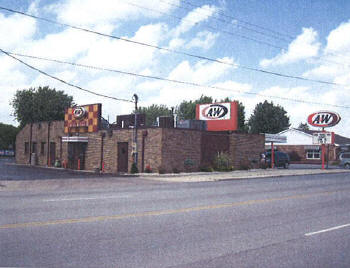 |
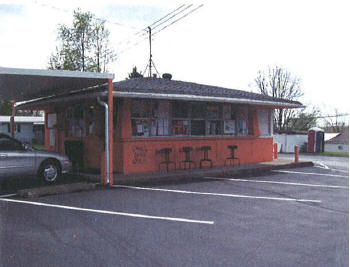 |
(Left) A&W Restaurant in Delphos; (Right) Stewart’s Root Beer stand in Mansfield
The Journal also reports that Allen purchased the recipe for his product from a pharmacist in Arizona. Like the claims of so many other products, the recipe is "still a closely guarded secret." I have to admit that among all the typical canned products on the grocery store shelf, A&W remains my favorite. In fact, I like it as much if not better than all of the premium brands. I don't know if it is because of the vanilla, or if it is because I grew up drinking A&W and therefore find myself measuring all other brands against it. Anyway, a 'brown cow' made with A&W is as good as it gets whether it is summer or winter.
Another popular drive-in destination in my area of Ohio was the Stewart's Root Beer Drive-In. Sadly, our location in Lima closed before I became a teenager, but happily, other franchises still survive in Ohio. This includes a location on State Route 430 (post-1928 route of Lincoln Highway) east of Mansfield, the home town of the brand's founder. It is still painted in the traditional Stewart's orange color, and apparently continues to offer 'car hop' service. A similar Stewart's site is on Route 4 on the north side of Marion, Ohio appears to still be using intercoms as well.
According to the Journal, "Frank Stewart created Stewart's Root Beer in 1924 as a way to supplement his income as a schoolteacher in Mansfield. He wanted to make the world's best-tasting root beer, which he soon learned tasted much better in tall, frosted mugs. He opened [his first] drive-in in Mansfield, and it was an instant success."
During the first sixty-six years of business, Stewart's Root Beer was only available at Stewart's stands or drive-ins. However, in 1990, the bottling rights were acquired by a larger corporation, and that corporation continues to sell the product in the "signature 12-ounce amber glass bottles." More recently, the product line has expanded to include several other flavors, none of which appeal to this author as much as the original staple.
I would be remiss not to mention that the A&W in Delphos and the Stewart's in Mansfield have both helped promote the annual Lincoln Highway BuyWay Yard Sale event. The last time I checked, both locations still offered souvenir mugs. Like Frank Stewart discovered, root beer does taste better in a tall, frosted mug. This summer, our family conducted an unofficial taste test of every root beer brand we could purchase in the stores. The kids seem to like the products with the most fizz, and I seem to like the brands with vanilla. My wife's choices were inconclusive. The Henry Weinhard product--which adds vanilla much in the same manner as A&W—was the premium brand most like my lifelong standard, and got bonus points because it consistently poured a wonderfully foamy and tasty head. It was as close to a ‘brown cow’ as one can get without adding the ice cream.
Readers are encouraged to contact Buckeye Ramblings to report other surviving root beer stands along the Lincoln Highway in Ohio. Those of you who really enjoy the beverage may also report your observations from any unofficial taste tests in which you have participated. Can anyone think of a better science project to do with the kids than a root beer taste test.
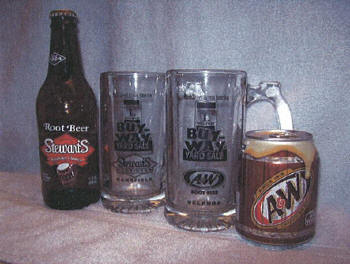 |
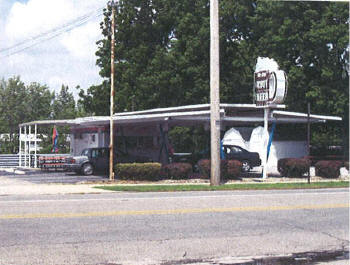 |
(Left) The iconic colors and logos of two popular root beer brands, both of which feature roadside locations on the Lincoln Highway in Ohio and BuyWay souvenir mugs; (Right) The B&K Root Beer stand on the Lincoln Highway west of downtown Van Wert. B&K is a Midwestern chain with locations in Ohio, Indiana, and Michigan. According to Wikipedia, the initials stand for “Bergerson & Kenefick,” and at one time the chain had as many as 238 locations in three states.
VAN WERT ERECTS NEW LINCOLN HIGHWAY GATEWAY SIGNS
Keeping their fine record of trendsetting tasks intact, the good folks in Van Wert can be proud of yet another new project. Two impressive gateway signs have been located at the city limits west and east of town on the Lincoln Highway. The western gateway sign is opposite the Brookside Dairy near John Brown Road, and the eastern gateway sign (see image on sheet two) is near the southwest corner of the Marsh Foundation property. The project was the brainchild of LHA member Larry Webb, who was also instrumental in getting “Historic Byway” status for the Lincoln Highway in Ohio. Larry has probably accomplished more interesting Lincoln Highway tasks in his home town and home county than any other Ohioan. Money to build the gateway signs was raised by a local group which has asked to remain anonymous. Larry originally presented the idea to the “Main Street, Incorporated” group in Van Wert when he was a member of that committee, and they enthusiastically backed his idea—paying any bills that were not otherwise covered by donations. The brick pillars that flank the sign are built to the same standards as the original brick pillars that were erected in Crawford County and other western counties of Ohio during the 1920s, and were laid up by a local bricklayer. The cement capstones were constructed from a mold fashioned by Richard Taylor of the Mid-Ohio Chapter (see related story on sheet one). The “Welcome” sign was designed by a local architect, and all parts were in place just in time for the annual Lincoln Highway BuyWay Yard Sale Event. Congratulations to Larry and his Van Wert friends on a job well done.
UPCOMING EVENTS
MID-OHIO CHAPTER:
For information regarding chapter activities, contact Chapter President Mike McNaull at mmcnaull@hotmail.com or 419-281-3064
Sunday November 8—Road Trip to Delphos Canal Commission Museum in Delphos, Ohio
EASTERN OHIO CHAPTER:
For information regarding chapter activities, contact Acting Chapter President Jim Cassler at
info@lhtp.com or 330-456-8319
Thursday November 12—Dinner Meeting: time and place to be determined
Thursday December 10—Christmas Party Meeting: at Kosmo’s in Massillon
OHIO LINCOLN HIGHWAY HERITAGE CORRIDOR
August 5-7, 2010—Lincoln Highway BuyWay Yard Sale
Thank you to LHA/OLHL member Jim Cassler and The Klingstedt Brothers Company, who have donated the envelopes that were used to mail this newsletter. Jim and his associates are the official suppliers of Lincoln Highway Merchandise. Members are encouraged to visit the web site at www.LHTP.com for a look at the impressive inventory of items.
Buckeye Ramblings is the newsletter of the Ohio Lincoln Highway League, our state affiliate of the Lincoln Highway Association. Editor of this newsletter and president of the OLHL is Mike Buettner (1618 Chandler Drive/ Lima, Ohio/ 45805). Any changes of address should be forwarded to Mike at his home address, or by contacting his office via e-mail at mgbuettner@kohlikaliher.com or by phone at 419-227-1135. Other officers through April 2010 are Mike McNaull, Vice-President; Tammy Buettner, Secretary; and Michael Lester, Treasurer. For texts of back issues, plus photography and other Ohio information, visit the web site created and maintained by Jim Ross at www.lincolnhighwayoh.com.
Costs for printing and mailing this newsletter are covered entirely by LHA membership dues. Please renew your membership in the national association so that we can continue to publish news from Ohio on a regular basis. Readers now have the option of receiving this newsletter by way of electronic mail, which saves both time and costs.
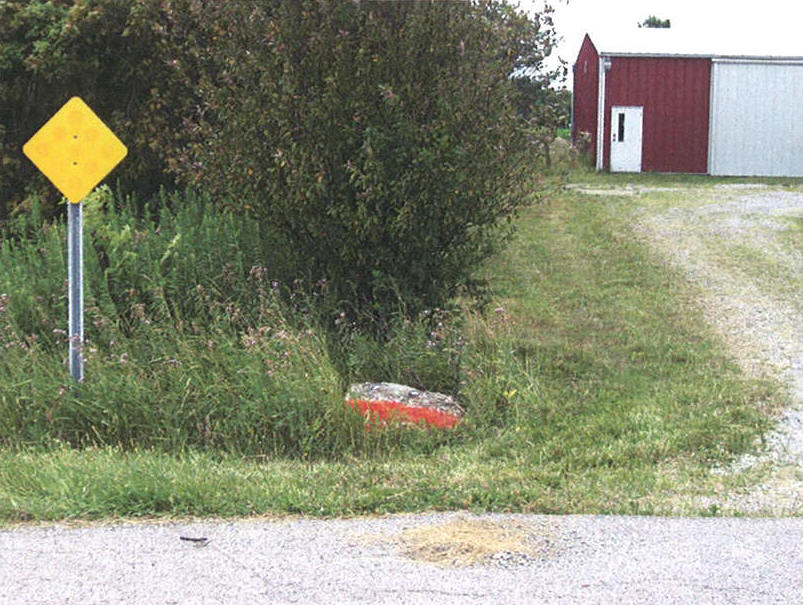
Question: What is so interesting about this picture?
Answer: It shows the location of yet another brick pillar in Ohio.
Based on a tip from LHA member Tom Kroske of Arlington, the editor stopped by this location while on his way home from the July 18 work day at Oceola. Sure enough, a concrete foundation that has the same dimensions as so many of the brick pillars in Ohio was easily visible in the summer weeds. This would be the nineteenth brick pillar location to be verified in Ohio, either by photographic evidence or by field observations. The location is one-half mile west of New Stark in Van Buren Township, or five miles west of Williamstown, on the south side of the roadway intersection where Township Road 60 tees into the Lincoln Highway [Note: Hancock County road signs also show C-304 (County Road 304) as an alternate designation for the Lincoln Highway].
This is actually the second Lincoln Highway pillar that Tom Kroske has verified in his home county. Tom was also aware that a brick pillar had once been located in Williamstown, at the northwest corner of the original main intersection of the small crossroads town. This was not only verified by an old photograph (see August 2007 edition of Buckeye Ramblings), but was also verified by its appearance on highway plans for the 1950s bypass project at Williamstown. The Eagle Creek Historical Organization, of which Tom is a member, is planning to erect a replica pillar at that same intersection during the summer of 2010, an event which should prove to be one of the highlights for the upcoming calendar year.
It is very likely that the two pillars were erected as a pair, although they are five miles apart. It appears to have been a highway department custom to place such brick pillars at the beginning and ending of a newly completed construction project.
For a complete listing of the locations of the eighteen other original brick pillars confirmed in Ohio, go to www.LincolnHighwayOh.com and click on the “Newsletter” link to access back issues of Buckeye Ramblings. Go to the May 2006 edition, where four full sheets are devoted to the brick pillars which are so unique in Ohio to the Lincoln Highway.
Here is a "Quiz Question" that originally appeared
in the August 2001 edition of Buckeye Ramblings:
Question:
Using the Songer Pillar east of Bucyrus as a standard, what is the minimum number of full bricks that would be needed to build the shell of a brick pillar?
Answer:
A minimum of 226 bricks are needed to erect the shell of such a pillar. This includes 7 bricks which would be broken or sawed in half. A typical tier contains 10 bricks, but the tiers around the dedication plaque and the Lincoln Highway logo sign contain 7 1/2 and 8 1/2 bricks, respectively. Altogether, there is a total of 25 tiers of bricks, with 1-4, 10-13, and 22-25 each containing the typical 10 bricks. 13 of the 14 half-bricks are used in the shell of the pillar, with the one half-brick remainder usually set inside the pillar along with various other reinforcing materials such as concrete block and unusable brick.